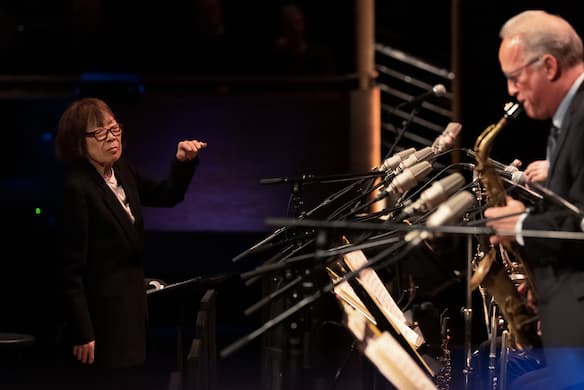Where Jazz Meets Japan: The Unique Voice of Toshiko Akiyoshi
The Jazz at Lincoln Center Orchestra plays 10 works by the 93-year-old, who appears with her husband and partner of more than 50 years, saxophonist and flautist Lew Tabackin, at Rose Hall.

‘The Music of Toshiko Akiyoshi’
Toshiko Akiyoshi and Lew Tabackin with the Jazz at Lincoln Center Orchestra
Musical Director: Ted Nash
In the more than 75-year career of pianist-composer-bandleader Toshiko Akiyoshi, there was a period when she felt at a disadvantage being a Japanese immigrant rather than a native-born American musician. Yet, she eventually realized that her heritage was not a liability but an asset, that she could compose original works for jazz orchestras that incorporated aspects of traditional Japanese music.
Her personal history helped give her a unique voice, and empowered her to create a music that sounds like no one else’s in the century-old evolution of jazz.
All of this was very much in evidence in “The Music of Toshiko Akiyoshi,” performed by the 93-year-old Ms. Akiyoshi and her husband and partner of more than 50 years, saxophonist and flautist Lew Tabackin, on Friday and Saturday at Rose Hall with the Jazz at Lincoln Center Orchestra.
Ms. Akiyoshi’s theme song, “Long Yellow Road,” made this point tersely at the beginning of the night; it effectively combines American jazz and Japanese sounds in a short, eventful tune with sharp dramatic pauses that almost suggest a samurai in action.
The first full piece of the evening was “Desert Lady,” an original by Mr. Tabackin that I have heard him play many times with his own, smaller groups; he explained at the outset that Ms. Akiyoshi’s luxurious big band orchestration is more properly titled “Desert Lady / Fantasy.”
The piece comes in several distinct sections, starting with Mr. Tabackin soloing on flute over a slow but persistent percussion pattern, reinforced by Paul Nedzela’s bass clarinet. It could depict a dromedary plodding across the dunes. As Mr. Tabackin’s flute solo intensifies, the piece changes moods and tempos behind him, growing louder and faster. The middle section includes an expressive solo by trombonist Elliot Mason accompanied only by drummer Obed Calvaire; it sounds as much Afro-Cuban as Middle Eastern or Asian. The piece grows ever darker and more menacing until it shifts moods again, back to the slower tempo and Mr. Tabackin’s flute.
Over the course of one evening, the Jazz at Lincoln Center Orchestra, with saxophonist Ted Nash serving as musical director and host, played fully 10 works by Ms. Akiyoshi and Mr. Tabackin. For several pieces, such as the boppish “Studio J,” Ms. Akiyoshi played the piano part, taking over from the regular JALC keyboardist, Dan Nimmer.
The evening also included two tribute works, starting with Ms. Akiyoshi’s very original, new reworking of Duke Ellington’s 1927 “Black and Tan Fantasy”; the piece begins and ends with muted trumpets paraphrasing Chopin’s funeral march, as always, but the second strain is here played on flutes rather than clarinets, giving it a very different sound. There were spots for Marcus Printup’s bright, open-belled trumpet; Mr. Nedzela’s warm baritone sax, evoking the spirit of his predecessor, Joe Temperley; and the lusty, big-toned tenor of Mr. Tabackin, playing over a stop-time background.
The other dedication was “Farewell (to Mingus),” composed in honor of the only major jazz figure that she enjoyed an extended opportunity to work with as a sideman, Charles Mingus. The piece includes echoes of Mingus’s own dedicatory works, like “Goodbye Porkpie Hat” and “So Long Eric,” for Lester Young and Eric Dolphy, respectively. Mr. Tabackin soloed mournfully over a background of flutes and a bass trombone part played by orchestra guest Tim Newman, and there also was a moving piano eulogy by the composer.
Several pieces were highly Japanese in character, such as “Kogun,” inspired by the legendary last soldier of World War II, which used special Asian percussion instruments on a pre-recorded track. The major extravaganza of the second half was “Since Perry / Yet Another Tear,” which, as Ms. Akiyoshi related, was inspired by a breakthrough moment in Japanese history.
The piece began with Mr. Calviere replicating Japanese ceremonial drums, but the basic content was highly American; there was a fast and highly swinging segment based on “I Got Rhythm” changes and reminiscent of “Cottontail,” followed by a slow ballad by Mr. Tabackin, which he introduced as being inspired by the passing of Ben Webster and other saxophone giants, with echoes of “Body and Soul.”
The announced final work was “Epilogue – Hope,” from a 2001 work commissioned to commemorate the tragedy of Hiroshima, but which Ms. Akiyoshi cast with an optimistic slant, emphasizing the future.
It was a long evening — more than two and a half hours — but a highly rewarding one, with no dull spots. Following “Hope,” Ms. Akiyoshi started playing the unannounced encore, “Hangin’ Loose” (from Mr. Tabackin’s 1976 album “Tenor Gladness”), a very swingy, Basie-esque style riff number. Trumpeter Tatum Greenblatt and Mr. Nash both soloed, but this was still another rewarding moment for Mr. Tabackin. He began wailing on his tenor, and just didn’t stop. In mid-solo, the trumpets slowly filed off stage, then the trombones, and the saxes. Bassist Carlos Enriquez left next, followed by Mr. Nimmer leading Ms. Akiyoshi, and then Mr. Calviere.
Mr. Tabackin was now completely unaccompanied, and totally undisturbed. He kept soloing for a few minutes and then gradually trucked off the stage himself, still playing. For all I know, he’s still playing even now.

